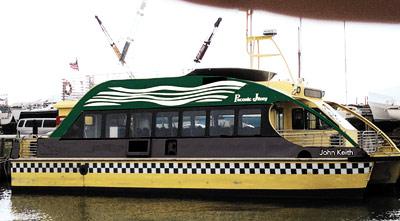It’s Anchors Aweigh for Ferry In Sag Harbor

After a Coast Guard inspection today and a county vote on Tuesday, the Peconic Jitney passenger ferry will be able to hit the harbor for 100 days. Many voices of opposition were heard yet again at the final hearing on the matter Tuesday night, but the Sag Harbor Village Board voted 4 to 1 in favor of issuing a temporary special permit for passenger ferry travel from Long Wharf to Greenport.
The ferry service is planned to begin on or about June 28, with seven round trips a day Sunday through Wednesday and nine from Thursday through Saturday for a price of $11 one way and $20 round trip. Fares for children 13 and younger will be $6 one way, $11 round trip, according to Geoff Lynch, the president of Hampton Jitney and of the newly formed and separate entity Peconic Jitney. Mr. Lynch, a Sag Harbor resident, will use his family-owned company’s money for the trial run.
“We don’t have a chance to make a red cent,” he announced at Tuesday’s hearing. “It has to do with transit on the East End — not just Sag Harbor, all five towns.” Mr. Lynch explained that he saw the trial period as an opportunity to enhance transportation, as outlined in a portion of a transportation study by Sustainable East End Development Strategies, for the long-term benefit of the region. He said bicycles would be welcomed on the boats for no additional charge.
“If we can come up with a long-term plan that alleviates traffic, every person in the village will win,” Mr. Lynch said.
Also approved despite opposition of neighbors was the lease of a parking lot from Pierson High School for Peconic Jitney to use for a shuttle for those who drive to the village to take the ferry. The lease was Mr. Lynch’s response to an outcry about the already disastrous parking situation in the village during the summer. The Sag Harbor School Board will receive $20,000 for the use of the lot when school is not in session.
Some residents said they were concerned about “unacceptable” effects on Sag Harbor and its quality of life and didn’t see sufficient benefits. Fears cited included the safety of children sailing, parking, pollution, overcrowded streets, and a decrease in property values.
But Bruce Stafford, a village board member, could see benefits, one of them being access to Greenport’s many family-friendly activities, such as a skate park and a carousel. “I have a 12-year old,” he said. “We can walk downtown, hop on the boat, and have a great day.” He also said that, despite the mostly negative comments at the hearings, he has heard a lot of positive ones from people on the street.
The board reassured those in attendance that when the trial period is over, a permanent application would require a much more substantial review, which would involve the Harbor Committee, the village’s planning and zoning boards, and the architectural review board.
Mr. Lynch estimated a maximum passenger count of 350 people per day, which he called “not an overwhelming number.” The boat holds 53 people. As a guide, Hampton Jitney buses usually operate at 40 to 50-percent occupancy, he said. “I don’t think 175 will have cars. I can handle most of those cars if I do my job of marketing it that way.”
Mr. Lynch also spoke of plans for expansion to other ports, such as Orient, New Suffolk, and Montauk, “if this looks like it has potential.”
“This boat goes away after September,” he said, and for the service to continue, investors or public-sector grants would be required, as would more boats.
Jim Ryan, the owner of Response Marine and “employee number-one” at Peconic Jitney, explained nautical details for the board, for example the fact that the boat will come in even with the bulkhead at high tide, thus not disrupting any scenic vistas. It has its own gangplank for passengers to board.
“Four cleats are the only footprint,” Mr. Ryan said, along with a sign showing hours of operation and fees. He said the ferry would not travel at more than five knots near the harbor. “We don’t want to disturb people,” whether they are fishing, anchored, or sailing. He said those in the shellfish industry had been assured their traps would not be disturbed.
Opponents, however, also complained Tuesday about the buses that the new enterprise is to run in a loop, in conjunction with the ferry schedule, to and from Bridgehampton and East Hampton.
Mr. Lynch countered that the county’s S92 transit bus is the “best deal in the Hamptons” and said he would prefer that passengers take advantage of its 16 daily runs to East Hampton, Sag Harbor, and Bridgehampton. “Anybody can get on for $2.25.”
Jeff Peters of the Harbor Committee, the sole member of that body who believes the ferry plan is not consistent with the village’s Local Waterfront Revitalization Plan, spoke as a resident of Main Street and questioned the fee of $12,000 for the use of Long Wharf. “It is going to cost more than that. It’s common sense,” he said, pounding the podium.
On Monday at a Harbor Committee meeting, Mr. Peters said he was concerned about the disruption of activities at the north end of Long Wharf. “We don’t know how it will displace the fishermen and visitors to the wharf,” he said.
“I really want to try this for the summer and see how it works,” Mayor Brian Gilbride said Tuesday night. “If it does work out, or it doesn’t work out, I want to have as much information as we can to study this. This provides the data, that’s the real story.”
“I think it’s worth a try,” Mr. Lynch said. “I am willing to take the loss to do the research and do a study for the East End.”
